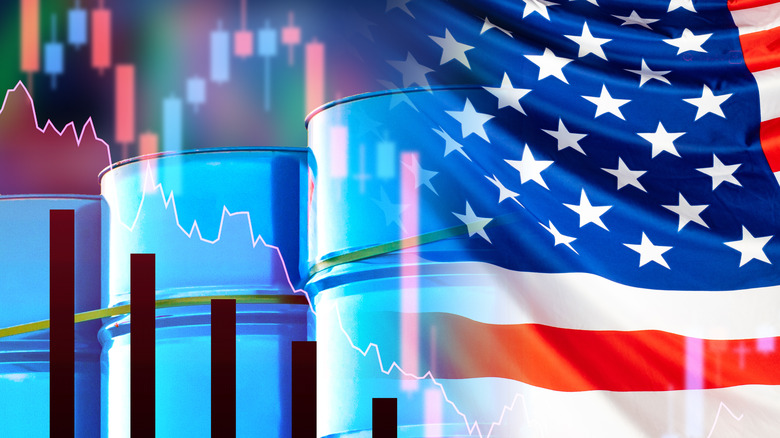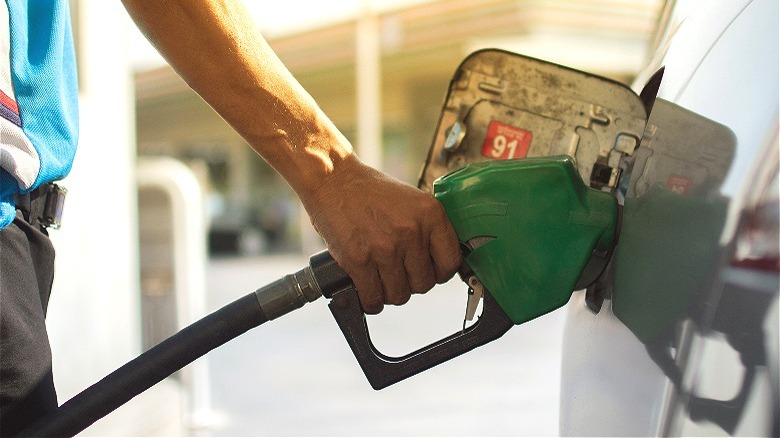Where Is The U.S. Gasoline Supply Reserve, And Who's In Charge Of It?
In a stated effort to keep prices low at the pump for travelers this summer, President Joe Biden announced on May 21 that nearly 1 million barrels of gasoline would be released from the Northeast Gasoline Supply Reserve before June 30. As the stretch between Memorial Day and July 4 is known to be a hotspot for traveling, there are certainly things you can do to use less gas while driving during the season. However, the injection of supply should hopefully provide a small counterbalance to the increase in demand for gas, ensuring that American motorists aren't gouged while filling up their tanks. This said, the Department of Energy has also announced plans to sell the reserves entirely (following a mandate from Congress), meaning the gasoline would need to be released regardless.
But gasoline isn't the only thing flowing in excess. Since the announcement, a steady stream of misinformation and confusion has abounded with regard to Biden's petrol plan. The United States manages a vast network of fossil fuel reserves, and is both a major exporter and importer of energy in the global market. Most of these systems are rather opaque to the public, who rarely interface with them directly, even as they're affected by them at the gas station. So, what exactly is the Gasoline Supply Reserve, what it isn't, and who's in charge of it?
The NGSR, located across multiple states, is closing
The reserves from which President Biden released 1 million barrels of gasoline are located across multiple states and were established in the wake of Superstorm Sandy, which decimated the Eastern seaboard when it made landfall there in late 2012. As a result of the storm, some gas stations were left without fuel for 30 days, per the Department of Energy. In 2013, then-President Barack Obama responded by establishing a system of emergency gasoline reserves to support backup systems in the event of another such act of God. At the time, former Gov. Andrew Cuomo announced the reserves would be held in Long Island, New York, and earmarked $10 million for the project, which became known as the Northeast Gasoline Supply Reserve, or NGSR. It was officially established by former Energy Secretary Ernest Moniz on June 20, 2014, and is managed by the Department of Energy.
Two sites were chosen for the reserves. The first, in the New York Harbor of Long Island, holds about 900,000 barrels of gasoline, while the second, in South Portland, Maine, holds 100,000. Since the reserve holds a total of 1 million barrels, Biden's release of that same amount during the 2024 summer season will effectively drain the reserve of its entire supply. Although the president and the DOE framed it as a boost meant to alleviate prices at the pump, the move coincided with the DOE's announcement that the Northeast Gasoline Supply Reserve was to be sold and liquidated. The sale was mandated back in March as part of an omnibus spending bill.
As reported by Reuters, as of May 21 when Biden announced the release, East Coast gasoline inventories stood at 55.5 million barrels in a high-supply market, further reducing the impact of the sale.
Don't confuse it with the Strategic Petroleum Reserve
There has been some confusion floating around since the White House announced the release of gasoline from the Northeast Gasoline Supply Reserve, and some have apparently conflated it with the Strategic Petroleum Reserve, or SPR. However, the two are separate entities. While the NGSR is a relatively small emergency reserve that holds 1 million barrels of refined gasoline — the kind you can put right in your car — the Strategic Petroleum Reserve, located along the Gulf of Mexico, holds crude oil that must be refined into gasoline and other fuels before it can be put to use.
While the Northeast Gasoline Supply Reserve was intended for emergency use in the tri-state area, the SPR is the world's largest emergency store of crude oil. At its peak, it held 727 million barrels of petroleum. It is intended to ward off threats by hostile, oil-producing nations that might threaten to weaken the United States by choking its oil supply. The petroleum reserve is primarily controlled by the president, at whose sole discretion and authorization sales from the reserve are determined.
President Biden did dip heavily into the supply during the first half of his term, especially as the Russo-Ukrainian War ramped up in its early stages. By the start of 2023, an estimated 42% of the Strategic Petroleum Reserve was depleted through sales authorized by Biden. Since Russia is a major exporter of oil, the sales were intended to stabilize prices. Although that goal was somewhat achieved as the price of a gallon of gasoline went down by 40 cents, the petroleum sales became a political albatross for Biden as Republicans accused him of weakening America's energy independence. What's more, gas prices rose again soon after.


